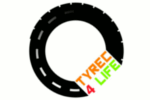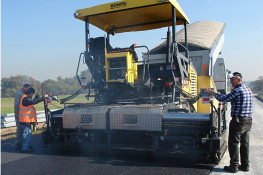FOUR PROJECT RESULTS
1. Application of LCA (Life Cycle Assessment)
The ELV (End of Life Vehicles) and ELT(End of Life Tyres) management systems in use in Italy and other countries (European and non-European) were investigated in light of the current laws and directives. ELT recycling and energy recovery technologies were analysed and compared. Features of the technologies were determined by analysing the available literature and in the course of numerous technical visits to plants located in Italy. We could thus confirm, also on the basis of the quantitative data taken into account, that ELT recycling may effectively contribute to reaching the EU objectives for ELV exploitation, and that in this perspective their use in bituminous conglomerates for road paving is particularly advantageous from the technical and environmental points of view.
2. Construction of the first plant in Italy for the production of hot dry technology conglomerates
The system set up by Brillada Vittorio in their facilities in Borgaro Torinese is the second in Italy dedicated to these technologies.
3. Asphalting with different mixtures using wet and dry technologies
- Paving of a stretch approximately 1 km long on Provincial Road 503 Baio Dora, in the town of Borgofranco di Ivrea (wet - gap-graded technology)
- Paving of a stretch approximately 1 km long on Provincial Road 53 in the town of San Giorgio Canavese (wet - dense-graded technology)
- Paving of two separate stretches on a local road (approximately 2 km long) in the town of Settimo Torinese (wet - dense-graded technology and wet - gap-graded technology). In addition to the use of the tested bituminous mixtures, the latter is particularly interesting because it was carried out on a very damaged road, this situation being extremely common on our roads
- Paving of approximately 3300 square metres of paving in the town of Borgaro Torinese (where the Brillada Vittorio & C. plant is located) (dry technology)
4. Construction of an innovative Life Cycle Risk Assessment (LCRA)
Focused on evaluating the potential impacts on the environment and health of workers determined by the use of road construction and paving maintenance techniques in which ELT powder is used. During preliminary assessments, the life cycle was analysed by comparing the environmental performance of bituminous mixtures containing ELT powder (made using wet and dry technologies) with those of traditional type mixtures, demonstrating that the use of mixtures made using wet technology can provide significant benefits in terms of energy saving, environmental impact and reduced exploitation of resources. These advantages are guaranteed only if the bituminous mixtures are designed and applied according to rules of best practice with the corresponding possibility of reducing wearing course thickness and maintenance frequency. In the case of dry technology, it is has been found that the eco-profiles of the corresponding paving are approximately equivalent to those of a traditional type road paving. With regards to Risk Analysis (RA), a first comparison between the various examined technologies was performed during the previous studies focusing on HQ (Hazard Quotient) and on IELCR (Individual Excess Life Cancer Risk) parameters. Testing of the paving applied in the scope of the TYREC4LIFE project is underway.
PROSPECTS
For projects such as TYREC4LIFE to have a real impact, the steps of studying and testing must be carried out and completed by disseminating the results and sensitising on the issue. However, creating demand is fundamental. The latter is an essential condition for the widespread use of innovative products also in relation to specific needs of Public Administration, which is increasingly more often called to purchase, plan, construct and maintain works in accordance with Green Public Procurement (GPP) principles. The importance of GPP is reasserted in the European Commission Communications on Sustainable Consumption and Production, in addition to many other documents. The Action Plan for Environment Sustainability of Consumptions of Public Administration written by the Italian Ministry of the Environment quantifies real objectives although these are still disregarded: the national objective to be reached was 50% (by number and value) of 'green' contracts on the total of public contracts stipulated for each appointment and supply category by 2014. In particular, the National Action Plan includes designing and constructing so-called 'green roads' among the eleven categories of application of GPP. A 'green road' is defined as a "road designed and constructed with criteria of greater natural resource use efficiency and lower life cycle environment impacts with respect to a conventional road, i.e. designed and constructed with criteria and materials currently in use in the local administrative reference context". The Minimum Environmental Criteria (Criteri Ambientali Minimi - CAM) for 'green roads' are currently being defined by the Ministry of the Environment.In this specific context, the use of conglomerates with the addition of ELT powder is priority and certainly destined to cause the interest of the various concerned parties. Thus, it is extremely important to be able to come into contact with the stakeholders, particularly those directly involved in technical and planning decision-making, but also in political decision-making, to convey the results of the project.Information on tests carried out and on the consequent results over the past years of activity is certainly the first step to involve political and technical decision-makers on central and local levels, this condition being essential for the conclusion of the design work.
DOCUMENTS
- Brochures
- Tyrec4life project - Introduction (pdf 1,7 MB)
- Tyrec4life project - Brochure (pdf 1,2 MB)
- Tyrec4life project - Summary sheet (pdf 3,4 MB)
- Reports
- Action 2.1 (pdf 1,5 MB)
Evaluation of the current status of the recycling/energy recovery - Action 2.2 (pdf 815 KB)
Environmental evaluation of the recycling technologies - Action 2.3 (pdf 1,3 MB)
Environmental evaluation of the use of crumb rubber - Action 2.4 (pdf 460 KB)
Evaluation of the current status of aggregates - Action 2.5 (pdf 285 KB)
Evaluation of the current status of the crumb rubber availability in Italy - Action 2.6 (pdf 698 KB)
Screening for alternative material at short supply distance - Action 3.1 (pdf 520 KB)
Characterization of asphalt rubber binders - Action 3.2 (pdf 291,6 KB)
Technical specifications for the mix design and quality assurance of bituminous mixtures - Action 3.2 (pdf 398 KB)
Characterization of bituminous mixtures containing crumb rubber from ELTs - Actions 3.3.1, 3.3.2, 3.4 and 3.5 (pdf 1,7 MB)
Technical guidelines for the field implementation of the “dry” technology - Action 3.6 (pdf 1,41 MB)
Technical guidelines for the field implementation of the “dry” technology - Action 4.1 (pdf 1,41 MB)
Project delivery - Site monitoring report - Action 4.3 (pdf 1,24 MB)
Road pavement monitoring - Skid resistance and roughness - Action 4.4 (pdf 474,3 KB)
Road pavement monitoring - Technical and environmental parameters - Action 5 (pdf 971 KB)
Life cycle risk assessment - Action 6.8.5 (pdf 971 KB)
Benefit Assessment of Project Profitability (BAPP) - Action 7 (pdf 2,63 MB)
After Life Communication Plan - Layman's report (pdf 1,3 MB)
- Action 2.1 (pdf 1,5 MB)
- Fact sheets
- Fact sheet 2.1 (pdf 4,9 MB)
Evaluation current status of the recycling/energy recovery - Fact sheet 2.2 (pdf 660 KB)
Life Cycle Assessment of recycling technologies of rubber powder - Fact sheet 2.3 (pdf 491 KB)
Environmental evaluation of innovative asphalts - Fact sheet 2.4 (pdf 1,7 MB)
Evaluation of the current status of aggregates available for bituminous mixtures - Fact sheet 2.5 (pdf 1,3 MB)
Evaluation of the current status of the scrap tyre rubber availability in Italy - Fact sheet 2.6 (pdf 495 KB)
Screening for alternative material at short supply distance - Fact sheet 3.1 (pdf 1,2 MB)
Characterization of bitumen and bitumen-rubber mixtures - Fact sheet 3.2 (pdf 306 KB)
Characterization of bituminous mixtures containing scrap tyre rubber - Fact sheet 3.3.1 (pdf 234 KB)
Design of a mixing prototype device for dry mixtures containing crumb rubber - Fact sheet 3.3.2 (pdf 404 KB)
Design of a mixing prototype device for dry mixtures containing crumb rubber - Fact sheet 3.4 (pdf 366 KB)
Solutions for the reduction of energy consumption and gaseous emissions in the dry technology - Fact sheet 3.5 (pdf 280 KB)
Trial reduced-scale experimental sections with dry technology - Fact sheet 4.1 (pdf 607 KB)
Design and construction of pavement test sections containing asphalt rubber mixtures - Fact sheet 4.2 (pdf 317 KB)
Design and construction of pavement test sections containing asphalt rubber mixtures - Fact sheet 4.3 e 4.4 (pdf 370 KB)
Monitoring of pavement test sections - Fact sheet 5 (pdf 728 KB)
Life Cycle Assessment of road pavements containing crumb rubber
- Fact sheet 2.1 (pdf 4,9 MB)
- Detailed time schedule (pdf 28 KB)
- Geolocation (zip 29 KB)
Partners:
Co-financier:










